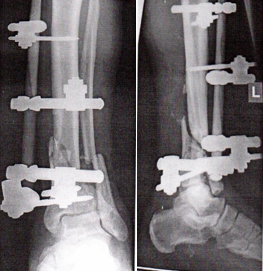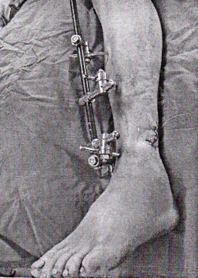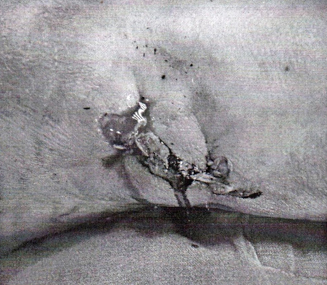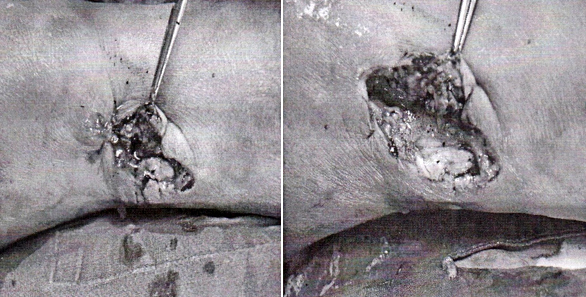| |
|
|
INTRODUCTION
Open fractures of the shinbone occur as a result of direct or
indirect force and belong to the most severe fractures of the
musculoskeletal system. In open fractures of the shinbone, damage to
surrounding soft tissues creates highly unfavorable biological
conditions for fracture healing. Due to the impairment of both
intramedullary and periosteal vascularization, open fractures of the
shinbone are predisposed to delayed healing and the development of
pseudoarthrosis, with a constant risk of infection and osteitis [1].
The treatment of open fractures of the shinbone is challenging due
to the extent of the injury. External skeletal fixation is commonly
employed in the treatment of open fractures today. When using
external skeletal fixation for the treatment of open fractures, good
stability is achieved with minimal additional damage to the soft
tissue envelope of the shinbone. The pins of the external skeletal
fixator are placed away from the fracture site, minimizing
additional damage to the intramedullary and periosteal
vascularization of the bone in the fracture zone, which is crucial
for fracture healing [2].
The treatment of open fractures of the shinbone involves removing
all foreign bodies from the open fracture wound, thorough irrigation
of the wound with saline and hydrogen peroxide, debridement of
damaged tissues, fracture stabilization, and delayed closure of the
open fracture wound
Open fractures of the shinbone occur as a result of direct or
indirect force and are among the most severe fractures of the
locomotor system. In open fractures of the shinbone, there is damage
to surrounding soft tissues, creating very unfavorable biological
conditions for fracture healing. Due to damage to both
intramedullary and periosteal vascularization, open fractures of the
shinbone are predisposed to slow healing and the development of
pseudoarthrosis, with a constant threat of infection and osteitis
[1]. Treating open fractures of the shinbone is accompanied by
significant difficulties due to the extent of the injury. External
skeletal fixation is now used in the treatment of open fractures.
When applying external skeletal fixation in the treatment of open
fractures, good stability is achieved with minimal additional damage
to the soft tissue envelope of the shinbone. The pins of the
external skeletal fixator are placed away from the fracture site to
avoid further damage to intramedullary and periosteal
vascularization in the fracture zone, which is crucial for fracture
healing [2]. Treatment of open fractures of the shinbone involves
removing all foreign bodies from the wound, thorough irrigation of
the wound with physiological solution and hydrogen peroxide,
debridement of damaged tissues, fracture stabilization, and delayed
closure of the open fracture wound.
OBJECTIVE OF THE STUDY
The aim of our study is to present the treatment of a
polytraumatized patient with an open fracture of the shinbone using
external skeletal fixation with the Mitković unilateral external
fixator. The treatment goal is to avoid primary amputation and to
restore full function of the injured limb.
MATERIAL AND METHOD OF WORK
The study depicts a polytraumatized patient with an open fracture
of the shinbone, who underwent primary wound management followed by
external skeletal fixation, and closure of the open fracture wound
with primary sutures. However, during the subsequent course of
treatment, the patient developed severe infection and sepsis.
CASE REPORT
A 58-year-old patient sustained an open fracture of the shinbone
by falling from a height of approximately 4 meters, landing on
stacked logs.
Upon admission to the hospital, the patient was prepared for
surgical intervention, and a reduction and external skeletal
fixation of the shinbone were performed. The open fracture wound of
the shinbone was primarily sutured (see images 1 and 2).
Fig. 1 and 2. X-ray images of the open fracture of
the shinbone after the realignment of bone fragments and
stabilization of the fracture with an external skeletal fixator.

Fig. 3. Condition after stabilization of the open fracture of the
distal third of the shinbone using an external skeletal fixator.

Due to a head injury, the patient was hospitalized in the
neurosurgery clinic. During the treatment, the patient developed
high fever. A follow-up examination was conducted, during which the
primary sutured wound of the open fracture of the shinbone was
observed, with inflammation and purulent discharge between the wound
sutures.
Fig. 4. The wound of the open fracture of the
shinbone is inflamed, and there is purulent discharge present
between the wound sutures.

Fig. 5 and 6. The sutures used to close the open fracture wound
initially were removed from the wound, and foreign material, soil,
and pus were found within the wound.

The wound was thoroughly irrigated, and wound debridement was
performed layer by layer for the open fracture of the shinbone.
Foreign material was removed, and the wound was extensively
irrigated again. Following the debridement of the open fracture
wound, the wound was not sutured but left open (see images 7 and 8).
Fig. 7 and 8. The condition of the wound after
debridement and thorough irrigation. Following debridement, the open
fracture wound was left open.

The patient was prescribed antibiotic therapy (amp. Ceftriakson
2g/24h, amp. Amikacin 1g/24h, and Metronidazol 500mg/8h). Following
the wound debridement and antibiotic therapy, the temperature
normalized, and the wound healed. After the fracture healed and
physical therapy, the patient returned to their work and daily
activities.
DISCUSSION
Open fractures of the shinbone are the most common open fractures
of long bones. They occur as a result of direct or indirect force.
Direct mechanisms of injuring the shinbone typically occur in
traffic accidents, during agricultural work, falls from great
heights, gunshot wounds to the shin region, and so forth. Indirect
mechanisms of injury lead to the majority of shinbone fractures
during sports activities such as skiing, falls, or other
sports-related activities. Damage to the soft tissues of the
shinbone usually occurs due to high-intensity force or displacement
of sharp bone fragments that penetrate the soft tissues from within.
In open fractures, there is communication between the fracture site
and the external environment. Open fractures are primarily
contaminated with microorganisms from the external environment.
In the clinical presentation of an open fracture of the shinbone,
there is communication of the fracture site with the external
environment, pain, deformity, bleeding, hematoma, local swelling,
pathological mobility, and loss of function of the injured limb. Due
to the potential injury to major blood vessels, it is necessary to
check pulses such as the dorsalis pedis artery, anterior tibial
artery, and posterior tibial artery. Radiological diagnostics
(conventional X-rays, MSCT, magnetic resonance imaging) are the most
significant and precise methods to gain insight into the shape of
the shinbone fracture, the degree of displacement, and the location
of the fracture. X-ray imaging of the diaphysis of the injured
shinbone in two directions with the knee and ankle joints should be
conducted to avoid missing associated fractures at the joint levels.
Upon admission of the patient with an open fracture of the shinbone,
a clinical examination and X-ray diagnostics should be performed if
the patient's condition allows or after resuscitation. Inspect the
open fracture wound and take a wound swab for culture and antibiotic
susceptibility testing. In the operating room, irrigate the wound
with physiological saline and hydrogen peroxide (sometimes it may be
necessary to use up to ten liters of fluid for wound irrigation),
and remove all visible foreign bodies from the wound. After that,
prepare the surgical field in the standard manner. One of the most
important procedures in combating infection in open fractures is the
primary surgical wound management (debridement, removal of damaged
and devitalized tissues), which provide a good substrate for the
development of bone infection, osteomyelitis, or specific infections
such as gas gangrene and tetanus. Debridement is performed from the
surface to the deeper layers of the wound. Firstly, debride the
skin. The skin is resistant to trauma, and caution should be
exercised during debridement to avoid creating a large defect
unnecessarily. Only remove damaged and avascular parts of the skin.
Skin vitality is assessed based on capillary bleeding. Skin that
bleeds upon incision is vital and should not be removed.
Subcutaneous fat tissue is poorly vascularized and avascular parts
should be removed. Damaged fascia is also removed. If necessary to
facilitate repositioning and irrigation of the wound, the fascial
opening can be extended longitudinally proximally and distally with
a longitudinal incision [5]. It is crucial to perform meticulous
(good) debridement of muscle tissue. During muscle debridement, we
use the 4K rule (color, consistency, bleeding, contractility).
Muscle that does not have a nice pink color is likely avascular,
necrotic. Crushed muscle that tears when grasped with forceps is
likely avascular. Muscle that does not bleed when incised and does
not contract when grasped with forceps or touched with diathermy is
likely avascular. During muscle debridement, small portions of
muscle with a diameter of about 1cm are removed piece by piece to
avoid creating a large defect in vital tissue indiscriminately. It
is necessary to remove all avascular, necrotic tissues. If we are
unsure about the tissue's vitality, debridement can be repeated
after 24 hours or 48 hours when avascular, necrotic tissues will
demarcate (primary, secondary, tertiary, etc., debridement).
Debridement should be repeated until all avascular, necrotic tissues
are removed from the wound. After debridement of the open fracture
wound, it should be irrigated again [6].
After the realignment of fractured fragments of the shinbone, the
fracture is stabilized with an external skeletal fixator or an
Ilizarov apparatus. Vital structures such as major blood vessels,
nerves, and bone tissue are covered with vital muscle tissue if
possible. Other structures such as fascia, skin, and subcutaneous
tissue are not closed. The wound of the open fracture is not
primarily closed but managed with methods such as delayed primary
closure, secondary closure, skin grafting, fasciocutaneous flap, or
another method, once it is ensured that there is no wound infection
[7,8].
Antibiotic therapy is initiated immediately after wound swab
collection but before the surgical procedure. It is crucial that
antibiotic therapy is administered to the patient as soon as
possible. A cephalosporin and an aminoglycoside antibiotic are
prescribed (Ceftriakson 2g/24h, Amikacin 1.0g/24h) to cover both
gram-positive and gram-negative flora. If the open fracture is
contaminated with agricultural soil, metronidazole 500mg/8h is also
prescribed to prevent gas gangrene. Tetanus prophylaxis is
administered according to the standard protocol [8,10]. Good
debridement is the best prevention against infection, gas gangrene,
and tetanus.
Complications in the treatment of open fractures of the shinbone
include infection of the open fracture wound, infection around the
pins or wires of the external skeletal fixator, deep bone infection
(osteomyelitis), gas gangrene, tetanus, delayed healing, healing in
poor position, nonunion, limb amputation, etc. [11].
CONCLUSION
Treatment of open fractures of the shinbone includes removing all
foreign bodies from the wound, thorough irrigation of the open
fracture wound with saline and hydrogen peroxide, debridement of
damaged tissues until there is no avascular necrotic tissue
remaining in the wound, stabilization of the fracture with an
external skeletal fixator, antibiotic therapy, and tetanus
prophylaxis. The wound of the open fracture is closed when it is
ensured that there are no signs of infection, either with delayed
primary closure or secondary closure, using skin grafts,
fasciocutaneous flaps, microvascular flaps, etc.
Complications in the treatment of open fractures of the shinbone
include delayed healing, infection of the open fracture wound,
infection around the pins of the external skeletal fixator,
osteomyelitis, nonunion (septic or aseptic), limb amputation, and so
on.
LITERATURE:
- Court-Brown CM, Mac Birnie J. The epidemiology of tibial
fractures. J Bone Joint Surg(Br). 1995; 77: 417-21.
- Mitković M, Bumbasirević M, Golubović Z et all. New concept
in external fixation. Acta Chir Iugosla. 2005; 52(2): 107-11.
- Gustilo RB, Mendoza RM, Williams DN. Problems in the
management of type III (severe) open fractures. A new
classification of type III open fractures. J Trauma. 1984; 24:
742-6.
- Golubović Z, Stojiljković P, Mačukanović-Golubović L, Milić
D, Milenković S. et al. Lečenje otvorenih preloma potkolenice
metodom spoljne skletne fiksacije. Vojnosanitet Pregl. 2008;
65(5): 343- 7.
- Patzakis MJ, Harvey JP, Ivler D. The role of antibiotics in
the management of open fractures. J Bone Joint Surg Am. 1974;
56: 532-41.
- Olson SA. Instructional Course Lectures, The American
Academy of Orthopaedic Surgeons Open Fractures of the - Tibial
Shaft. Current Treatment. J Bone Joint Surg Am. 1996; 78:
1428-37.
- Fischer MD, Gustilo RB, Varecka TF. The timing of flap
coverage, bone grafting and intramedullary nailing in patients
who have a fractura with extensive soft-tissue injury. J Bone
Joint Surg Am. 1991; 73: 1316-22.
- Caudle RJ, Stern PJ. Severe open fractures of the tibia. J
Bone Joint Surg Am. 1987; 69: 801-7.
- Ivan Golubović, Branko Ristić, Predrag Stoiljković, Milan
Ćirić, et all.Results of open tibial, fracture treatment using
external fixation. Srpski Arhiv za celokupno lekarstvo,
2016;144(5-6):293-299.
- Stoiljković P, Jovanović M, Golubović I, Radovanović Z,
Stevanović G, Mitić A, Zoran Golubović. Hiruško lečenje
otvorenog preloma potkolenice, sa lezijom magistralnih krvnih
sudova, Prikaz slučaja. Vojnosanitetski pregled, 2018;75(4):
422-427.
- Zoran Golubović et all: Complications in the treatment of
segmental tibial fractures. Timok Medical Gazette
2021;46(3):132-136.
|
|
|
|





